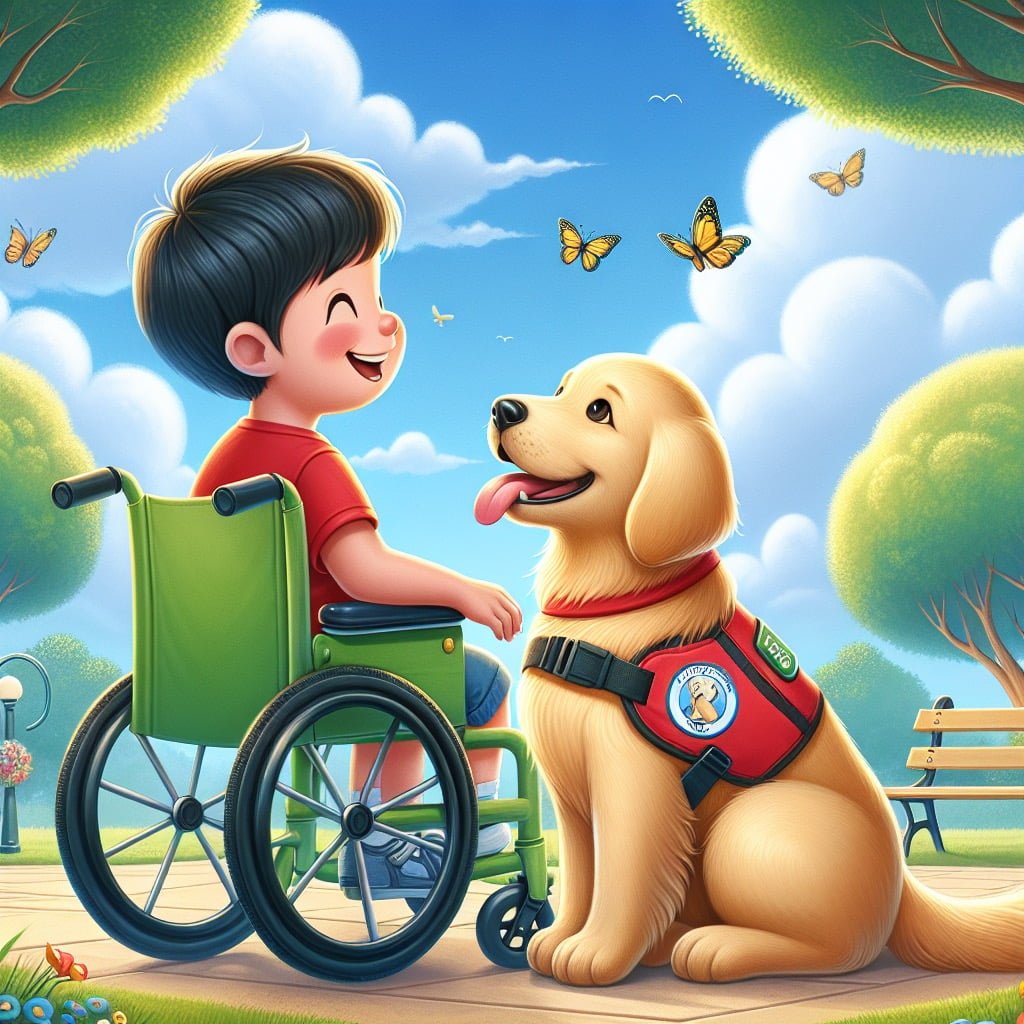Welcome to our fascinating exploration of Dog Facts For Kids! Dogs are truly remarkable creatures with incredible abilities that have captivated and enriched our lives for thousands of years. From their extraordinary sense of smell to their understanding of human emotions, dogs never fail to amaze us with their unique talents and unwavering loyalty. Join us on a journey through the world of fun facts about dogs, where we uncover the fascinating secrets behind our beloved canine companions. Get ready to be enchanted by the fascinating world of dogs and gain a deeper appreciation for the special bond we share with these amazing animals. Let’s dive into the exciting realm of Dog Facts For Kids and discover the wonders of the dog kingdom together!
Dog Facts For Kids
1. Dogs Have a Strong Sense of Smell

For younger kids: Dogs have an amazing nose that helps them find treats and friends!
For older kids: Dogs have approximately 300 million olfactory receptors in their noses, compared to about 5-6 million in humans, allowing them to detect scents with incredible precision.
Detailed explanation:Dogs have a remarkably strong sense of smell, which is considered one of their most important and impressive abilities. In fact, their sense of smell is estimated to be tens of thousands of times more powerful than that of humans. This incredible olfactory prowess is due to the large number of scent receptors in their noses – on average, a dog has around 220 million scent receptors, while a human has only about 5 million.
This heightened sense of smell allows dogs to detect scents that are undetectable to humans, making them invaluable in activities such as search and rescue, tracking, and detecting explosives or drugs. Dogs are able to differentiate between a vast array of scents, even picking up on individual components of a scent that may be masked by others. This is why dogs are often used in law enforcement to help solve crimes or locate missing persons.
For children, learning about dog facts can be both educational and fascinating. Understanding the extraordinary sense of smell that dogs possess can help kids better appreciate and respect their canine companions. It can also serve as a fun way to engage children in learning more about animals and their unique abilities.
In conclusion, dogs truly have a remarkable sense of smell that sets them apart from other animals, including humans. Their olfactory abilities play a crucial role in various aspects of society, from search and rescue operations to law enforcement. By sharing fun and interesting Dog Facts For Kids, we can foster a greater understanding and appreciation for these amazing creatures.
Dog Facts For Kids
2. Dogs Understand Human Emotions

For younger kids: Dogs can tell when you’re happy or sad and want to make you feel better.
For older kids: Studies have shown that dogs can recognize human emotions by interpreting facial expressions, vocal cues, and body language, enabling them to offer comfort and support.
Detailed explanation:Dog Facts For Kids are always fascinating to learn about, and one interesting fact is that dogs are able to understand human emotions. Research has shown that dogs have the ability to not only recognize human emotions, but also respond to them in a way that shows empathy and understanding.
One study conducted at the University of Helsinki found that dogs are able to recognize the difference between happy and angry expressions on human faces. The researchers used eye-tracking technology to monitor the dogs’ gaze as they looked at images of human faces displaying different emotions. The results showed that dogs spend more time looking at the eyes of happy faces, indicating that they are able to pick up on the positive emotions expressed through facial expressions.
Another study published in the journal Animal Cognition found that dogs are more likely to approach someone who is crying or in distress, compared to someone who is neutral or not showing any emotion. This suggests that dogs are able to detect when their human companions are upset and are motivated to provide comfort and support.
Overall, these studies provide evidence that dogs have a unique ability to understand human emotions, making them not only loyal and loving companions, but also intuitive and empathetic beings. So, next time you’re feeling down, you can count on your furry friend to be there for you and offer some comfort, thanks to their remarkable understanding of human emotions. Dog Facts For Kids truly showcase the amazing bond between humans and their canine companions.
Dog Facts For Kids
3. A Dog’s Sense of Hearing Is Sharper Than Ours

For younger kids: Dogs can hear sounds that are too quiet for us to notice!
For older kids: Dogs can hear frequencies up to 65,000 Hz, far beyond the human range of 20,000 Hz, allowing them to detect high-pitched sounds and distant noises.
Detailed explanation:When it comes to the animal kingdom, dogs are known for their exceptional senses, and one of the most impressive of these is their sense of hearing. In fact, a dog’s sense of hearing is much sharper than that of humans. This ability is due to the structure of a dog’s ear, which is specifically designed to capture and amplify sound waves.
Dog Facts For Kids show that dogs have a unique anatomy that allows them to hear frequencies that are much higher than what humans can detect. While humans can typically hear sounds in the range of 20 to 20,000 Hz, dogs can hear frequencies up to 65,000 Hz. This means that dogs can detect sounds that are much quieter and more subtle than what we are capable of hearing.
One of the key reasons for this heightened sense of hearing in dogs is their ability to move their ears independently, allowing them to pinpoint the exact location of a sound. This is especially useful for hunting or tracking prey, as dogs can use their acute sense of hearing to detect the faintest rustle of leaves or the slightest footstep.
Additionally, dogs are also able to hear sounds at much greater distances than humans. While we may struggle to hear something from across a room, a dog can pick up on sounds from much farther away. This ability is a remnant of their wild ancestors, who needed to be able to hear predators or prey approaching from a distance.
Overall, a dog’s sense of hearing is a remarkable and essential trait that plays a crucial role in their daily lives. Whether they are listening for their owner’s voice, detecting the sound of a doorbell, or chasing after a squeaky toy, dogs rely heavily on their acute sense of hearing to navigate the world around them.
Dog Facts For Kids
4. The Basenji Dog Cannot Bark

For younger kids: The Basenji dog makes funny yodel-like sounds instead of barking.
For older kids: The Basenji breed is unique in that it cannot bark; instead, it produces a sound described as a “barroo” or a yodel, making it a quieter companion.
Detailed explanation:One fascinating fact about the Basenji dog breed is that they are unable to bark. This unique trait sets them apart from most other dog breeds, making them quite special in the canine world. Instead of barking like a typical dog, Basenjis produce a sound that is often described as a yodel or a chortle. This is due to the shape of their larynx, which is different from that of other dogs and prevents them from barking in the traditional sense.
Basenjis are known for being independent and intelligent dogs, traits that likely play a role in their inability to bark. Instead of relying on vocalizations to communicate, Basenjis often use body language and facial expressions to convey their emotions and intentions. This makes them unique among dog breeds and adds to their appeal for many dog lovers.
Despite their inability to bark, Basenjis are still excellent watch dogs and can be quite vocal when they want to be. They are also known for their agility and speed, which make them great companions for active individuals and families. Basenjis have a strong hunting instinct, so it is important for owners to provide them with plenty of exercise and mental stimulation to keep them happy and healthy.
In conclusion, the fact that Basenjis cannot bark is just one of the many interesting aspects of this ancient dog breed. Their unique vocalizations, combined with their intelligence and independence, make them a fascinating breed to learn about and interact with. Let’s continue to explore more fun **Dog Facts For Kids** to discover all the amazing diversity and quirks that make dogs such special companions.
Dog Facts For Kids
5. Dogs Can Learn Hundreds of Words

For younger kids: Dogs are so smart, they can understand many words and commands!
For older kids: Studies have demonstrated that some dogs can learn and recognize hundreds of words and commands, showing an impressive capacity for language comprehension.
Detailed explanation:Dogs are incredibly intelligent animals, capable of learning a wide range of commands and words. In fact, studies have shown that dogs have the ability to learn hundreds of words, making them one of the most linguistically skilled animals in the animal kingdom. This fact is not only fascinating but also holds important implications for understanding the cognitive abilities of our canine companions.
Researchers have conducted numerous experiments to test the language learning abilities of dogs. Through these studies, it has been proven that dogs can not only recognize words but also understand their meanings in different contexts. This level of comprehension goes beyond simple conditioning or mimicry and suggests a deeper level of cognitive processing in dogs.
One famous example of a dog with extraordinary language skills is Chaser, a border collie who was able to learn the names of over 1,000 different objects. Chaser’s abilities demonstrated the incredible potential of dogs to grasp human language and communicate effectively with their human counterparts.
Understanding that dogs can learn hundreds of words has important implications for how we interact with and train our furry friends. By recognizing their linguistic abilities, we can tailor our training methods to effectively communicate with them and strengthen the bond between humans and dogs. This knowledge can also help in promoting the well-being and cognitive development of dogs, as we can provide them with mental stimulation through language-based activities and training exercises.
In conclusion, the fact that dogs can learn hundreds of words is a testament to their intelligence and cognitive abilities. By acknowledging and harnessing this aspect of their behavior, we can deepen our understanding of dogs and enhance the bond we share with our beloved pets.
Dog Facts For Kids
6. Dogs Have a Unique Paw Preference

For younger kids: Just like us, dogs can be left- or right-pawed!
For older kids: Research has revealed that dogs, like humans, can show a preference for using their left or right paws, which can be observed during activities such as reaching for objects or digging.
Detailed explanation:One interesting fact about dogs is that they have a unique paw preference, similar to how humans are right or left-handed. Just like humans favor one hand over the other for activities like writing or throwing a ball, dogs also tend to have a favored paw when it comes to tasks that require coordination, such as shaking hands or digging. This phenomenon is known as “pawedness” in dogs.
Research has shown that about 50% of dogs are right-pawed, while the remaining 50% are left-pawed or ambidextrous. This paw preference can be seen early on in a dog’s life, usually by the time they are six months old. By observing which paw a dog uses to reach for objects or perform certain actions, researchers can determine their preferred paw.
Understanding a dog’s paw preference can be useful for training purposes. By knowing whether a dog is right or left-pawed, trainers can tailor their methods to better suit the dog’s natural inclination. This can lead to more effective training sessions and better communication between the dog and its owner.
In conclusion, the fact that dogs have a unique paw preference, similar to humans being right or left-handed, is just one of the many fascinating aspects of canine behavior. By recognizing and understanding this aspect of dog behavior, we can further deepen our bond with these beloved animals. So next time you are playing with your dog, take note of which paw they prefer to use, it may just reveal a little bit more about their unique personality. Remember to share these interesting **Dog Facts For Kids** with your little ones to help them better understand and appreciate their furry friends.
Dog Facts For Kids
7. The World’s Smallest Dog Breed is the Chihuahua

For younger kids: The Chihuahua dog can be small enough to fit in a special bag!
For older kids: The Chihuahua holds the title for the world’s smallest dog breed, with adults typically weighing between 2 and 6 pounds, making them ideal companions for city-dwellers and apartment living.
Detailed explanation:One of the most fascinating **Dog Facts For Kids** is that the Chihuahua holds the title of the world’s smallest dog breed. These pint-sized pups are known for their tiny stature but big personalities. The Chihuahua is a toy breed that originated in Mexico and is known for being alert, lively, and fiercely loyal to their owners.
Despite their small size, Chihuahuas are packed with energy and spunk. Their compact bodies are covered in a short coat that can come in a wide variety of colors and patterns. These little dogs are often seen sporting sweaters or jackets to keep warm due to their low body fat and minimal body mass.
Chihuahuas are a popular choice for apartment dwellers and those living in urban environments due to their small size and adaptability. They also make excellent companions for older individuals or families with older children.
One interesting **Dog Facts For Kids** about Chihuahuas is that they have a long lifespan for a small breed, often living well into their teens if properly cared for. Like all dogs, Chihuahuas require regular exercise, mental stimulation, and proper nutrition to thrive.
In conclusion, the Chihuahua may be small in size but they are big in heart. They make loving and loyal companions for those willing to provide them with the care and attention they need.
Dog Facts For Kids
8. Dogs Dream When They Sleep

For younger kids: Dogs can have funny dreams just like we do!
For older kids: Research suggests that dogs experience similar sleep cycles to humans, including REM (rapid eye movement) sleep, during which they may dream and exhibit physical reactions like twitching or vocalizing.
Detailed explanation:One fascinating aspect of dog behavior is that they dream when they sleep. Just like humans, dogs go through different sleep cycles, including REM (rapid eye movement) sleep, which is when most dreaming occurs. During this stage of sleep, the brain is highly active, and dogs may exhibit twitching, whimpering, or even movements that mimic the actions they take while awake.
Studies have shown that dogs likely dream about activities that they do during the day, such as chasing a ball, running in a field, or interacting with their human family members. This indicates that dogs, like humans, process and consolidate memories and experiences during their dreams.
Dog Facts For Kids may find it interesting to know that the size and breed of a dog can affect how much they dream. Larger dogs tend to have longer and more intense dream periods, while smaller dogs may have shorter dreams. Additionally, dogs with more active lifestyles or who engage in mentally stimulating activities may have more vivid dreams.
It is important for dog owners to understand that when their furry companions are dreaming, it is best to let them sleep and not disturb them. Just like humans, dogs need quality sleep to recharge and stay healthy. So next time you see your dog twitching in their sleep, remember that they are likely dreaming about all the fun adventures they have had during the day.
Dog Facts For Kids
9. Up to 40% of a Dog’s Brain Is Responsible for Smell

For younger kids: A dog’s brain is amazing at helping them smell things they like!
For older kids: The area of a dog’s brain devoted to processing scents is significantly larger and more complex than that of humans, allowing them to interpret and analyze a wide array of odors in great detail.
Detailed explanation:Dogs have an incredibly keen sense of smell, much more powerful than that of humans. It is estimated that up to 40% of a dog’s brain is dedicated to processing smells, making their olfactory abilities far superior to ours. This means that dogs are able to pick up on scents that are undetectable to humans, making them exceptional hunters, trackers, and even medical aids.
One of the reasons for dogs’ impressive sense of smell is their large number of olfactory receptors. While humans have around 5 million olfactory receptors, dogs have up to 300 million, depending on the breed. This allows them to detect a wide range of smells with incredible precision and sensitivity.
Furthermore, dogs also have a specialized part of their brain called the olfactory bulb, which is responsible for processing smells. This part of the brain is significantly larger in dogs compared to humans, further enhancing their olfactory capabilities.
In addition to their biological adaptations for smell, dogs also have a strong instinctual drive to use their sense of smell. This is why they are often used in search and rescue missions, detecting drugs and explosives, and even identifying certain medical conditions in humans, such as seizures or cancer.
In conclusion, the fact that up to 40% of a dog’s brain is responsible for smell is a testament to the incredible olfactory abilities of these animals. Understanding this aspect of dogs’ physiology can help us appreciate and better utilize their unique talents. Remember, these fascinating Dog Facts For Kids can be a fun way to learn more about our furry friends.
Dog Facts For Kids
10. Dogs Can Help People with Disabilities

For younger kids: Some dogs are specially trained to help people who need it!
For older kids: Service dogs are trained to assist individuals with disabilities, providing support, guiding the visually impaired, alerting the deaf to sounds, and even responding to medical emergencies.
Detailed explanation:Dogs Can Help People with Disabilities
One of the most heartwarming and remarkable dog facts for kids is that dogs can play a crucial role in helping people with disabilities. Service dogs are specially trained to assist individuals with physical, mental, or emotional impairments, providing them with invaluable support and enhancing their quality of life. These remarkable animals undergo extensive training to learn how to perform a variety of tasks that can greatly benefit their human companions.
For individuals with visual impairments, guide dogs are trained to navigate obstacles, stop at curbs, and safely guide their handlers through busy streets. These highly skilled dogs provide their owners with a newfound sense of independence and freedom, allowing them to move around confidently and safely. Additionally, hearing dogs can alert individuals who are deaf or hard of hearing to important sounds, such as doorbells, alarms, or approaching vehicles, helping them stay aware of their surroundings.
Service dogs can also assist individuals with mobility impairments by retrieving items, opening doors, or providing balance support. For people with psychiatric disabilities, emotional support dogs can offer comfort, companionship, and a sense of security during times of distress. Therapy dogs are another type of service dog that visit hospitals, nursing homes, and schools to provide comfort and companionship to individuals in need.
Overall, dogs play a vital role in improving the lives of people with disabilities, offering not only practical assistance but also emotional support and companionship. These amazing animals truly demonstrate the incredible bond that can exist between humans and dogs, highlighting their remarkable ability to not only be our faithful companions but also our invaluable helpers in times of need.
Did You Know?
Dogs have been our faithful companions for over 15,000 years, evolving from wolves to become the lovable pets we cherish today, offering friendship and assistance in countless ways.
Summary of Dog Facts For Kids
Discovering fun facts about dogs can be an exciting and eye-opening experience for both children and adults alike. Not only are dogs fascinating creatures with amazing abilities, but they also hold a special place in our hearts as loyal and loving companions. By learning more about dogs, kids can develop a greater appreciation for the unique traits and behaviors of these wonderful animals.
Exploring dog facts can also be educational, helping to instill a sense of responsibility and empathy towards animals in children. Understanding the needs and behaviors of dogs can lead to better care and companionship for our furry friends. Additionally, delving into the world of dogs can spark curiosity and wonder about the natural world as a whole, showcasing the incredible diversity of life on Earth.
Whether you are a dog lover or simply curious about the amazing capabilities of these animals, diving into fun facts about dogs is a rewarding and enriching journey. It can deepen your connection with these beloved pets and inspire a newfound appreciation for the beauty and complexity of the animal kingdom. So, come along on this exciting adventure to uncover the wonders of dogs and the incredible bond they share with humans.
Sources and additional information for Dog Facts For Kids
WikipediaBritannicaSan Diego Zoo KidsThe Smithsonian InstitutionDK Find Out!Australian MuseumWorld Wildlife FundThe Nature ConservancyAnimal PlanetMonterey Bay AquariumPBS NatureSmithsonian’s National Zoo & Conservation Biology InstituteWorld Wildlife FundAnimal Diversity Web (University of Michigan)IUCN Red List of Threatened SpeciesThe Cornell Lab of Ornithology – All About BirdsNational Audubon SocietyEncyclopedia of LifeSeaWorld Parks & EntertainmentAustralian Museum – AnimalsEncyclopedia of Life




